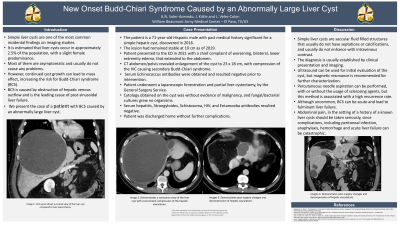Back


Poster Session C - Monday Afternoon
Category: Liver
C0580 - New Onset Budd-Chiari Syndrome Caused by an Abnormally Large Liver Cyst
Monday, October 24, 2022
3:00 PM – 5:00 PM ET
Location: Crown Ballroom

Has Audio

Ashley Soler-Acevedo, MD
William Beaumont Army Medical Center
El Paso, TX
Presenting Author(s)
Ashley Soler-Acevedo, MD, Jonathan Kittle, MD, Luis Velez-Colon, MD
William Beaumont Army Medical Center, El Paso, TX
Introduction: Simple liver cysts are one of the most common incidental findings on imaging studies. It is estimated that liver cysts occur in approximately 2.5% of the population, with a slight female predominance. Most of them are asymptomatic and usually do not cause any problems. However, if the cyst continues to grow it can cause compression of surrounding structures, increasing the risk for Budd-Chiari syndrome (BCS). BCS is caused by obstruction of hepatic venous outflow and is the leading cause of post-sinusoidal liver failure. We present the case of a patient with BCS caused by an abnormally large liver cyst.
Case Description/Methods: The patient is a 71-year-old Hispanic male with past medical history significant for a simple hepatic cyst, discovered in 2016. The lesion had remained stable at 10 cm as of 2019. Patient presented to the ED in 2021 with a chief complaint of worsening, bilateral, lower extremity edema that extended to the abdomen. CT abdomen/pelvis revealed enlargement of the cyst to 23 x 18 cm, with compression of the IVC causing secondary Budd-Chiari syndrome. Serum Echinococcus antibodies were obtained and resulted negative prior to intervention. Patient underwent a laparoscopic fenestration and partial liver cystectomy, by the General Surgery Service. Cytology obtained on the cyst was without evidence of malignancy, and fungal/bacterial cultures grew no organisms. Serum hepatitis, Strongyloides, Schistosoma, HIV, and Entamoeba antibodies resulted negative. Patient was discharged home without further complications.
Discussion: Simple liver cysts are saccular fluid filled structures that usually do not have septations or calcifications, and usually do not enhance with intravenous contrast. The diagnosis is usually established by clinical presentation and imaging. Ultrasound can be used to identify the characteristics of the cyst, but magnetic resonance is recommended for further characterization. Percutaneous needle aspiration can be performed, with or without the usage of sclerosing agents, but this method is associated with a high recurrence rate. Although uncommon, BCS can be acute and lead to fulminant liver failure. Abdominal pain, in the setting of a history of known liver cysts should be taken seriously, since complications including peritoneal infection, anaphylaxis, hemorrhage and acute liver failure can be catastrophic.

Disclosures:
Ashley Soler-Acevedo, MD, Jonathan Kittle, MD, Luis Velez-Colon, MD. C0580 - New Onset Budd-Chiari Syndrome Caused by an Abnormally Large Liver Cyst, ACG 2022 Annual Scientific Meeting Abstracts. Charlotte, NC: American College of Gastroenterology.
William Beaumont Army Medical Center, El Paso, TX
Introduction: Simple liver cysts are one of the most common incidental findings on imaging studies. It is estimated that liver cysts occur in approximately 2.5% of the population, with a slight female predominance. Most of them are asymptomatic and usually do not cause any problems. However, if the cyst continues to grow it can cause compression of surrounding structures, increasing the risk for Budd-Chiari syndrome (BCS). BCS is caused by obstruction of hepatic venous outflow and is the leading cause of post-sinusoidal liver failure. We present the case of a patient with BCS caused by an abnormally large liver cyst.
Case Description/Methods: The patient is a 71-year-old Hispanic male with past medical history significant for a simple hepatic cyst, discovered in 2016. The lesion had remained stable at 10 cm as of 2019. Patient presented to the ED in 2021 with a chief complaint of worsening, bilateral, lower extremity edema that extended to the abdomen. CT abdomen/pelvis revealed enlargement of the cyst to 23 x 18 cm, with compression of the IVC causing secondary Budd-Chiari syndrome. Serum Echinococcus antibodies were obtained and resulted negative prior to intervention. Patient underwent a laparoscopic fenestration and partial liver cystectomy, by the General Surgery Service. Cytology obtained on the cyst was without evidence of malignancy, and fungal/bacterial cultures grew no organisms. Serum hepatitis, Strongyloides, Schistosoma, HIV, and Entamoeba antibodies resulted negative. Patient was discharged home without further complications.
Discussion: Simple liver cysts are saccular fluid filled structures that usually do not have septations or calcifications, and usually do not enhance with intravenous contrast. The diagnosis is usually established by clinical presentation and imaging. Ultrasound can be used to identify the characteristics of the cyst, but magnetic resonance is recommended for further characterization. Percutaneous needle aspiration can be performed, with or without the usage of sclerosing agents, but this method is associated with a high recurrence rate. Although uncommon, BCS can be acute and lead to fulminant liver failure. Abdominal pain, in the setting of a history of known liver cysts should be taken seriously, since complications including peritoneal infection, anaphylaxis, hemorrhage and acute liver failure can be catastrophic.

Figure: Image 1: First panel shows a sagittal view of the liver cyst compared to liver parenchyma. Second panel demonstrates an axial view of the liver cyst with concomitant compression of the hepatic vasculature.
Disclosures:
Ashley Soler-Acevedo indicated no relevant financial relationships.
Jonathan Kittle indicated no relevant financial relationships.
Luis Velez-Colon indicated no relevant financial relationships.
Ashley Soler-Acevedo, MD, Jonathan Kittle, MD, Luis Velez-Colon, MD. C0580 - New Onset Budd-Chiari Syndrome Caused by an Abnormally Large Liver Cyst, ACG 2022 Annual Scientific Meeting Abstracts. Charlotte, NC: American College of Gastroenterology.

